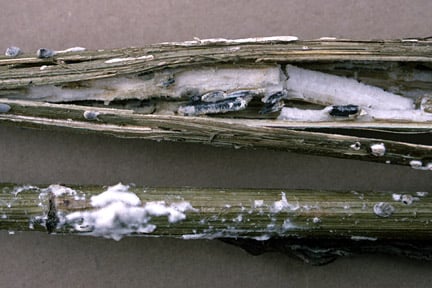
Quick facts
Common name - Sclerotinia disease
Scientific name - Sclerotinia sclerotiorum and other Sclerotinia or related species.
Plants affected - Many vegetables and ornamentals
Main symptoms - Rotting at stem base and white fluffy mould
Caused by - Fungus
Timing - Summer and early autumn
What is sclerotinia disease?
Sclerotinia disease is caused most commonly by the fungus Sclerotinia sclerotiorum. This fungus produces black, seed-like structures (sclerotia) that can survive for long periods in the soil, and causes disease in a very wide range of plants. Damage is seen in summer and early autumn.
S. sclerotiorum attacks a wide range of plants including vegetables: lettuce, beans, celery, chicory, cucumbers, tomatoes and peas; and many ornamentals, especially plants with hollow stems such as Delphinium, Dahlia and Helianthus (sunflower) and related yellow daisies.
In commercial agriculture and horticulture S. sclerotiorum is a major problem in lettuce, oilseed rape and sunflower production.
Other very similar Sclerotinia or related species attack gladioli (Stromatinia gladioli) and (Sclerotinia bulborum). In addition to Sclerotinia sclerotiorum, lettuce can also be affected by Sclerotinia minor.
Symptoms
You may see the following symptoms:
- Plants suddenly turn yellow, wilt and collapse
- A soft, wet rot on the plant stems, often near soil level, which may cause plants to collapse
- Masses of fluffy white fungal growth appear at the affected area
- Later, black, seed-like structures (sclerotia) 0.5–1cm (¼–½in) diameter appear in the white fungal growth. In plants with hollow stems the sclerotia also form in the stem cavity
- In gladioli: Infection causes a dry rot of the corms
- In hyacinths and other : Infection causes a wet rot of the bulbs

Control
Non-chemical control
- The most important control measure for gardeners is to remove and destroy affected plants promptly, to prevent the sclerotia from contaminating the soil
- Do not affected plants, as domestic compost heaps do not reliably reach temperatures high enough to kill sclerotia
Chemical control
There are no chemical treatments available to UK gardeners.
Biology
When plants infected with sclerotinia die, the black sclerotia fall to the soil, where they can remain viable for several years. It is these sclerotia that spread the disease. They can infect plants in two ways:
- Winter chilling followed by rising temperatures stimulate sclerotia to germinate and produce a structure called an apothecium, which looks like a small brown cup. This releases airborne spores which will land on leaves, and cause infection if that plant is susceptible. These spores require wet conditions to infect, so infections are more common in wet weather. Each apothecium can produce many thousands of spores, and if weather conditions are suitable outbreaks can be serious, especially in commercial crops
- Less frequently, the sclerotia germinate in the soil and infect plants directly. Fungal threads (hyphae) grow out from the sclerotium and through the soil, coming into contact with the base of the plant. This is especially likely when plants are crowded and the fungus only has to grow a short distance to encounter one. This is the same type of infection process that occurs in onion white rot





